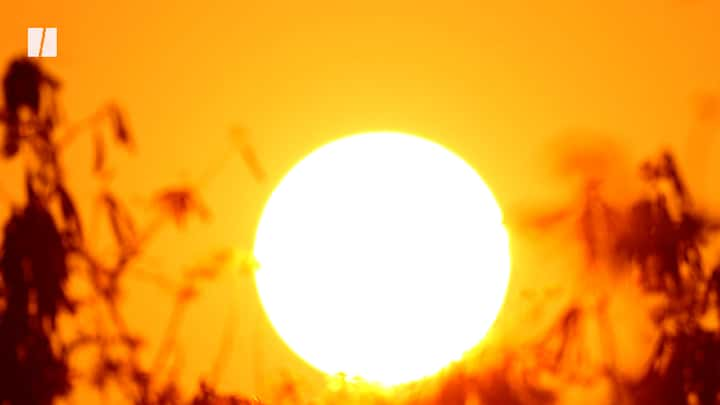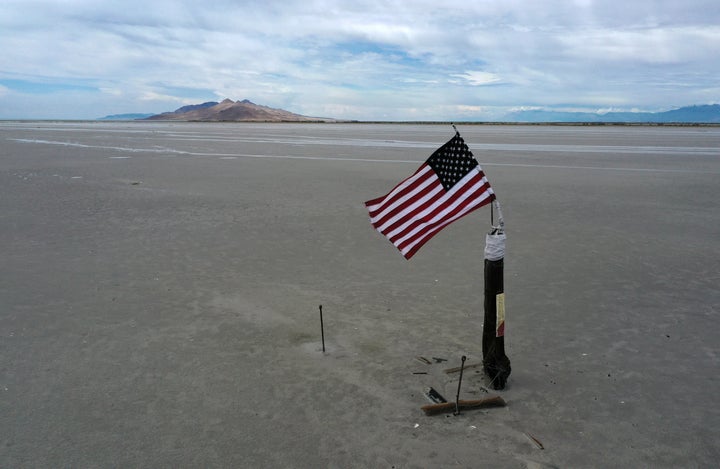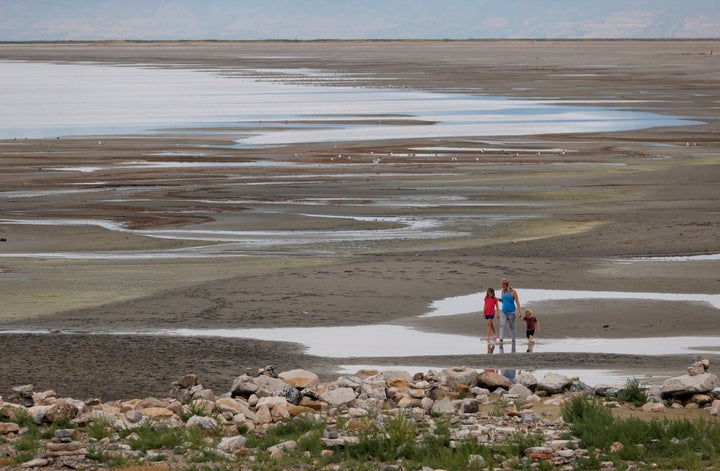The Utah lake dropped to its lowest level ever for the second time in one year. Officials call for "urgent action" to combat the climate change-induced drought.
By Marco Margaritoff
Jul 6, 2022,
HUFFPOST

The Great Salt Lake in Utah is drying up faster than ever, posing a huge threat to the economy and environment alike.
The Utah Department of Natural Resources and U.S. Geological Survey said in a joint statement Tuesday that this marks the second time in less than one year that the lake plummeted to historic low levels.The data revealed surface water elevation fell to 4,190.1 feet on Sunday. This is the lowest it has ever been since levels were first measured in the mid-1800s, according to CNN. While only slightly lower than the previous record in 2021, this downward trend poses serious ramifications.
An American flag waves over a part of the Great Salt Lake that used to be underwater.
JUSTIN SULLIVAN VIA GETTY IMAGES
“This is not the type of record we like to break,” Joel Ferry, executive director of the Department of Natural Resources, said in the statement. “Urgent action is needed to help protect and preserve this critical resource. It’s clear the lake is in trouble. We recognize more action and resources are needed, and we are actively working with the many stakeholders who value the lake.”
The largest saltwater lake in the Western Hemisphere, the Great Salt Lake registered its lowest-ever pre-2021 level at 4,191.4 feet elevation in October 1963. The current drought is rooted in climate change and resulting increases in water usage.
Officials noted that the body of water is evaporating and being used much faster than it’s being replenished. David O’Leary, investigative studies chief at the USGS’s Utah Water Science Center, nonetheless said the lake was in decent condition by fall 2021.
“In any given year, levels will rise and fall,” O’Leary told CNN. “Lake levels rise when inflows exceed evaporation and fall when evaporation exceeds inflows. Last year, when the historic low was previously broken, lake levels declined until mid-October before leveling off.”

This year's record broke last year's, which was the first time the Great Salt Lake's levels were lower than they were in 1963.
JUSTIN SULLIVAN VIA GETTY IMAGES
However, levels only “rose over one foot this past year,” Laura Vernon, the Great Salt Lake coordinator at the Department of Natural Resources, told CNN. She and her colleagues hope for at least 2.5 feet per year to replenish the water being lost.
USGS scientists previously warned low levels could threaten local wildlife, as the lake is a vital food source for an estimated 10 million migratory birds. This drought could also have devastating effects on the regional economy if the drought continues.
From the mineral and harvest industry to the tourism sector, the Great Salt Lake adds an annual $1.3 billion to the economy. If these arid conditions continue, anywhere between $1.7 billion to $2.2 billion could be lost each year — and 6,500 locals could lose their jobs.
“We need to be more aggressive in how we use water and how we manage water in the state,” Vernon told CNN. “We live in one of the driest states in the nation and we need to act like it.”

The Great Salt Lake in Utah is drying up faster than ever, posing a huge threat to the economy and environment alike.
The Utah Department of Natural Resources and U.S. Geological Survey said in a joint statement Tuesday that this marks the second time in less than one year that the lake plummeted to historic low levels.The data revealed surface water elevation fell to 4,190.1 feet on Sunday. This is the lowest it has ever been since levels were first measured in the mid-1800s, according to CNN. While only slightly lower than the previous record in 2021, this downward trend poses serious ramifications.

An American flag waves over a part of the Great Salt Lake that used to be underwater.
JUSTIN SULLIVAN VIA GETTY IMAGES
“This is not the type of record we like to break,” Joel Ferry, executive director of the Department of Natural Resources, said in the statement. “Urgent action is needed to help protect and preserve this critical resource. It’s clear the lake is in trouble. We recognize more action and resources are needed, and we are actively working with the many stakeholders who value the lake.”
The largest saltwater lake in the Western Hemisphere, the Great Salt Lake registered its lowest-ever pre-2021 level at 4,191.4 feet elevation in October 1963. The current drought is rooted in climate change and resulting increases in water usage.
Officials noted that the body of water is evaporating and being used much faster than it’s being replenished. David O’Leary, investigative studies chief at the USGS’s Utah Water Science Center, nonetheless said the lake was in decent condition by fall 2021.
“In any given year, levels will rise and fall,” O’Leary told CNN. “Lake levels rise when inflows exceed evaporation and fall when evaporation exceeds inflows. Last year, when the historic low was previously broken, lake levels declined until mid-October before leveling off.”

This year's record broke last year's, which was the first time the Great Salt Lake's levels were lower than they were in 1963.
JUSTIN SULLIVAN VIA GETTY IMAGES
However, levels only “rose over one foot this past year,” Laura Vernon, the Great Salt Lake coordinator at the Department of Natural Resources, told CNN. She and her colleagues hope for at least 2.5 feet per year to replenish the water being lost.
USGS scientists previously warned low levels could threaten local wildlife, as the lake is a vital food source for an estimated 10 million migratory birds. This drought could also have devastating effects on the regional economy if the drought continues.
From the mineral and harvest industry to the tourism sector, the Great Salt Lake adds an annual $1.3 billion to the economy. If these arid conditions continue, anywhere between $1.7 billion to $2.2 billion could be lost each year — and 6,500 locals could lose their jobs.
“We need to be more aggressive in how we use water and how we manage water in the state,” Vernon told CNN. “We live in one of the driest states in the nation and we need to act like it.”
No comments:
Post a Comment